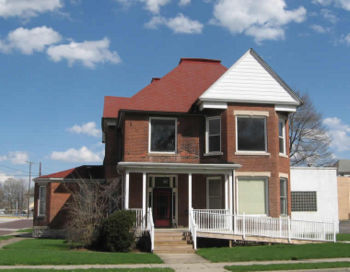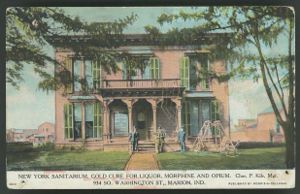Difference between revisions of "Seeker House"
(→Charles Kile's Sanitarium) |
|||
| (4 intermediate revisions by the same user not shown) | |||
| Line 1: | Line 1: | ||
| − | [[ | + | [[image:Seeker_House.jpg|thumb|350px]]Having stood for over one hundred years the house on 803 South Washington is an integral part of Marion history. Built in the 1890’s as housing for Marion’s upper class, the house was residential for a decade and a half. However, it is not know who resided in the house at this time. In the early twentieth century it was purchased by Charles “Chas” P. Kile who turned the house in the New York Sanitarium Gold Cure. The building was used as a rehab center for opiate addicts and alcoholics using the Keeley treatment to “cure” physical addictions. After the New York Sanitarium Gold Cure shut down it was used as an apartment complex until it was bought by Maurice Tilbury for his expanding furniture company, Morris Furniture. It remained as a furniture store until 1998 when the owner, Eugene Christopher, retired and it was bought by Gethsemane Episcopal Church and is used as the church’s offices (Indiana Directory). |
==Charles Kile's Sanitarium== | ==Charles Kile's Sanitarium== | ||
| − | [[image:Charles_Kile.jpg|thumb| | + | [[image:Charles_Kile.jpg|thumb|150px|left|Charles P. Kile, ca. 1890]]Charles P. Kile was a druggist and the editor of the Marion newspaper, “The Democrat”, which turned into the Marion-Leader Tribune. He opened the New York Sanitarium Gold Cure and competed with the local Keeley Institute. Dr. Lesley Keeley opened his first institute for the cure of addiction to alcohol and opium as well as a cure for neurasthenia in Dwight, Illinois in 1879. At these institutes, patients would have to commit themselves voluntarily or they would be turned away, they were able to come and go as they please as long as they were on grounds when the treatment was administered. The treatment is four weeks and for the first few days the patients are allowed to indulge in their addiction, they would be given the finest whiskey or opium, depending. They would then be injected with gold double chloride, which is essentially a fancy name for a placebo, gold double chloride is a chemical impossibility. The injection was so painful that anytime a client would feel a craving for his addiction he would feel violently ill. Along with the addiction would a patient would be tied to a chair for hours, or put up to his neck in ice water [www.fargohistory.net]. |
| − | This same idea is still in use to this day in aversion therapy which is still used today to treat severe drug and other psychological addictions. Apparently the treatment worked very well as is shown in the results of which always had very high success rates and very few relapses. He would take people whom were cured and use them as “missionaries” for his treatment. As a result Keeley Institutes started appearing all over the world, including Marion, Indiana. Keeley even started bottling products under his name at the enormous price nine dollars a bottle. At one point this method was so successful that stock in the Keeley Institute was selling at fifty dollars a share. With all this success imitators were bound to start appearing, as is the case with the New York Sanitarium Gold Cure. One can imagine that Kile saw a wonderful business opportunity before him and decided to open his own center for the treatment of addiction. The business did well until he retired in the twenties at which point the business closed down as well. Charles P. Kile died April 1, 1930 of natural causes, and was remembered more as a newspaper editor as opposed to a druggist (CT). The Keeley Institute in Marion was one of the last ones to close down, but it also shut down around the same time. | + | |
| + | [[Image:New_York_Sanitarium.jpg|thumb|300px|The New York Sanitarium, Gold Cure for liquor, Morphine and opium, Chas. P. Kile, Mgr. (ca. 1910)]]This same idea is still in use to this day in aversion therapy which is still used today to treat severe drug and other psychological addictions. Apparently the treatment worked very well as is shown in the results of which always had very high success rates and very few relapses. He would take people whom were cured and use them as “missionaries” for his treatment. As a result Keeley Institutes started appearing all over the world, including Marion, Indiana. Keeley even started bottling products under his name at the enormous price nine dollars a bottle. At one point this method was so successful that stock in the Keeley Institute was selling at fifty dollars a share. With all this success imitators were bound to start appearing, as is the case with the New York Sanitarium Gold Cure. One can imagine that Kile saw a wonderful business opportunity before him and decided to open his own center for the treatment of addiction. The business did well until he retired in the twenties at which point the business closed down as well. Charles P. Kile died April 1, 1930 of natural causes, and was remembered more as a newspaper editor as opposed to a druggist (CT). The Keeley Institute in Marion was one of the last ones to close down, but it also shut down around the same time. | ||
==Morris Furniture== | ==Morris Furniture== | ||
Latest revision as of 18:59, 20 June 2007
Having stood for over one hundred years the house on 803 South Washington is an integral part of Marion history. Built in the 1890’s as housing for Marion’s upper class, the house was residential for a decade and a half. However, it is not know who resided in the house at this time. In the early twentieth century it was purchased by Charles “Chas” P. Kile who turned the house in the New York Sanitarium Gold Cure. The building was used as a rehab center for opiate addicts and alcoholics using the Keeley treatment to “cure” physical addictions. After the New York Sanitarium Gold Cure shut down it was used as an apartment complex until it was bought by Maurice Tilbury for his expanding furniture company, Morris Furniture. It remained as a furniture store until 1998 when the owner, Eugene Christopher, retired and it was bought by Gethsemane Episcopal Church and is used as the church’s offices (Indiana Directory).Charles Kile's Sanitarium
Charles P. Kile was a druggist and the editor of the Marion newspaper, “The Democrat”, which turned into the Marion-Leader Tribune. He opened the New York Sanitarium Gold Cure and competed with the local Keeley Institute. Dr. Lesley Keeley opened his first institute for the cure of addiction to alcohol and opium as well as a cure for neurasthenia in Dwight, Illinois in 1879. At these institutes, patients would have to commit themselves voluntarily or they would be turned away, they were able to come and go as they please as long as they were on grounds when the treatment was administered. The treatment is four weeks and for the first few days the patients are allowed to indulge in their addiction, they would be given the finest whiskey or opium, depending. They would then be injected with gold double chloride, which is essentially a fancy name for a placebo, gold double chloride is a chemical impossibility. The injection was so painful that anytime a client would feel a craving for his addiction he would feel violently ill. Along with the addiction would a patient would be tied to a chair for hours, or put up to his neck in ice water [www.fargohistory.net].
Morris Furniture
After the closing of the New York Sanitarium Gold Cure closed down, the house on 803 South Washington was converted back into apartments. In 1936 Maurice Tilbury opened a furniture store on East 4th Street. He would look for ads in the paper of furniture for sale, he would then buy it and sell it back to the public at a profit. Eventually business picked up and Tilbury’s business began to grow and expand until he outgrew his little store and needed a bigger shop. In the early 1940’s Tilbury bought the house on 803 South Washington, and Morris Furniture to the new location. In 1948 Maurice Tilbury died of natural causes and one of his employees, Eugene Christopher, took over the store. Business continued to pick up and around 1949 the where house add-on was built which is still standing today. Business was then steady and successful until 1998 due what Mr. Christopher referred to as, “Many long hours of hard work and a good cliental (Christopher).”
In 1998, the house was sold to Gethsemane Episcopal Church after Mr. Christopher retired and shut down the furniture store. At this point the interior of the building was gutted and completely redone by local architect/ designer Rod Ashley. Ashley’s gutted the lobby and put up a large mural depicting a scene from the crusades. The rest of the bulding has been restored and given a fresh coat of paint, with the exceptions of the attic, warehouse, and basement. The building is currently being used as the offices for the church.
Conclusion
In conclusion, the house 803 Washington is very interesting yet often over looked part of Marion history. It has had the city of Marion grow around it, with many trends of era’s long since passed carried out within its walls. It housed trends in medicine that would be considered cruel and brutal by today’s standards. Then on to a more humble life as a furniture store and offices of a church, its history will be continued to unfold along with Marion’s.
Works Cited
“Charles P. Kile, Former Marion Editor, Died on Monday.” Marion Leader Tribune. 1 April, 1930.
Indiana Directory, Grant County, Indiana. 1895-1998.
“Maurice E. Tilbury.” Marion Chronicle Tribune. 31 March, 1968.
Christopher, Eugene. Personal Interview. 4 January, 2004
http://www.photoscotland.com/keeley/
http://www.larrysantiques.com/keeley.htm
http://www.fargo-history.com/hospitals/keeley.htm
Chronicle Tribune
Credits
Submitted by David Warnock on January 6, 2004 for Mr. Munn's AP U.S. History Class at Marion High School


